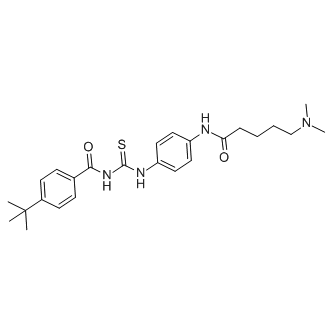| Description: |
Tenovin-6 is a water soluble inhibitor of SIRT1 and SIRT2, slightly inhibits HDAC8, and is also a potent activator of p53, with IC50s of 21 μM, 10 μM, and 67 μM for SirT1, SirT2, and SirT3, respectively. |
| Target: |
SIRT2:10 μM (IC50)
SIRT1:21 μM (IC50)
SIRT3:67 μM (IC50)
HDAC8
MDM-2/p53 |
| In Vivo: |
Tenovin-6 (50 mg/kg, i.p.) inhibits the growth of tumor in mice[1]. |
| In Vitro: |
Tenovin-6 inhibits the growth of S. cerevisiae cultures with an IC50 of 30 μM and is more toxic to yeast than the less water-soluble tenovin-1. Tenovin-6 rapidly increases the levels of endogenous K382-Ac p53 in MCF-7 cells[1]. Tenovin-6 (0 to 15 μM) dose dependently increases the level of LC3-II in diverse cell types, and the increase is ATG5/7 dependent. Tenovin-6 treatment also increases the number and intensity of autophagic vesicles with or without the presence of Torin 1, and prevents Torin 1-induced SQSTM1/p62 degradation. Tenovin-6 affects the acidification of autolysosomes and impairs the hydrolytic activity of lysosomes but does not affect the fusion between autophagosomes and lysosomes. That tenovin-6 inhibits autophagy does not correlate with p53 activation and SIRT1/2 inhibition by knockdown or knockout cannot mimic the effect of tenovin-6 on LC3B accumulation[2]. Tenovin-6 (0, 1, 2.5, 5 or 10 μM) potently inhibits cell proliferation in a dose- and time-dependent manner in all OCI-Ly1, DHL-10, U2932, RIVA, HBL1 and OCI-Ly10 cell lines. Tenovin-6 consistently increases LC3B-II level in DLBCL cell lines by inhibiting the classical autophagy pathway, without activating p53, and the increase is independent of SIRT1/2/3 and p53. Tenovin-6 induces apoptosis through the extrinsic cell-death pathway[3]. Tenovin-6 suppresses the growth of UM cells with IC50 of 12.8 μM, 11.0 μM, 14.58 μM and 9.62 μM for 92.1, Mel 270, Omm 1 and Omm 2.3 cells, respectively[4]. |
| Kinase Assay: |
Assays are carried out using purified components in the Fluor de Lys Fluorescent Assay Systems. Relevant FdL substrates are used at 7 μM and NAD+ at 1 mM. Tenovins are solubilized in DMSO with the final DSMO concentration in the reaction being less than 0.25%. For SirT1 and HDAC8, one unit of enzyme is used per reaction, and for SirT2 and SirT3, five units is used per reaction. Reactions are carried out at 37°C for 1 hr. |
| Cell Assay: |
The MTS assay is used to evaluate cell viability. UM cells are seeded into each well of 96-well plates (5,000 cells/well) and treated the next day with control or Tenovin-6 in an increasing concentrations from 0 to 20 μM for 68 h, and then MTS is added at 20 μL/well to be read at a wave length of 490 nm, the IC50 is determined by curve fitting of the sigmoidal dose-response curve. |
| Animal Administration: |
Female SCID mice are injected subcutaneously with 1×106 ARN8 cells suspended in matrigel. Tumors are allowed to reach a size of approximately 10 mm3. Tenovin-6 is administered daily at 50 mg/kg by intraperitoneal injection. Control animals are treated with vehicle solution containing cyclodextrin 20% (w/v) and DMSO 10% (v/v). Tumor diameters are measured using calipers, and volumes are calculated using the equation V=π4/3[(d1 + d2)/4]3. Median values of tumor size are calculated for each time point as well as the corresponding 95% confidence intervals. Comparison of control and drug-treated tumor size distributions are made by Mann-Whitney U-test. An alpha-level of 0.05 is considered appropriate for determination of statistical significance. |
| References: |
[1]. Lain S, et al. Discovery, in vivo activity, and mechanism of action of a small-molecule p53 activator. Cancer Cell. 2008 May;13(5):454-63.
[2]. Yuan H, et al. Tenovin-6 impairs autophagy by inhibiting autophagic flux. Cell Death Dis. 2017 Feb 9;8(2):e2608.
[3]. Yuan H, et al. Tenovin-6 inhibits proliferation and survival of diffuse large B-cell lymphoma cells by blocking autophagy. Oncotarget. 2017 Feb 28;8(9):14912-14924.
[4]. Dai W, et al. Class III-specific HDAC inhibitor Tenovin-6 induces apoptosis, suppresses migration and eliminates cancer stem cells in uveal melanoma. Sci Rep. 2016 Mar 4;6:22622. |

 DC Chemicals' products qualify for U.S. tariff exemptions. We guarantee no price increases due to customs duties and maintain stable supply, continuing to deliver reliable research solutions to our American clients.
DC Chemicals' products qualify for U.S. tariff exemptions. We guarantee no price increases due to customs duties and maintain stable supply, continuing to deliver reliable research solutions to our American clients.





















